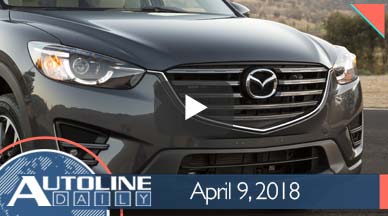
Runtime: 6:01
0:28 Trump Nominates NHTSA Chief
0:54 Chevy Spark on The Chopping Block
2:10 VW & Mazda Turn Around Sales
3:03 U.S. Q2 Sales Expected to Remain Solid
4:24 New Technique to Build Roads
Visit our sponsors to thank them for their support of Autoline Daily: Bridgestone , Dow Automotive Systems and Lear Corporation.
On today’s show…Mazda and Volkswagen turn around their sales in the U.S…the Chevy Spark could be on the chopping block…and a company in Turkey has developed a new way of building roads. All that and more coming right up on Autoline Daily.
This is Autoline Daily the show for enthusiasts of the automotive industry.
TRUMP NOMINATES NHTSA CHIEF
President Trump has finally nominated someone to become head of the National Highway Traffic Safety Administration, a position that’s been vacant since he took office. Heidi King, who is currently the deputy NHTSA administrator and has been the interim chief of NHTSA since September 2017, has been tapped to lead the agency. The nomination still needs approval from the Senate.
CHEVY SPARK ON THE CHOPPING BLOCK
Last week we reported that the Chevy Sonic and Impala will be discontinued. And now another vehicle in the brand’s lineup is on the chopping block. Reuters reports that GM’s South Korean unit says the Chevy Spark may be discontinued and replaced with a new crossover in 2022. But the plan is dependent on getting government support and concessions from the union. However, it’s easy to see why the Spark’s days could be numbered. Sales fell 36% last year in the U.S. On top of that, Opel sells a rebadged version of the Spark in Europe called the Karl, which is built in South Korea. But now that the brand is owned by PSA, Opel will start producing the vehicle in Europe starting in 2020.
Volkswagen and Mazda have turned around their sales thanks to management changes and refreshed lineups. And we’ll have more about that, right after this.
VW & MAZDA TURN AROUND SALES
Two companies to keep an eye on in the American market this year are Mazda and Volkswagen. Both companies have made major management changes and revamped their product lines and it’s really paying off. Mazda’s sales are up 21% for the first quarter of the year, while Volkswagen’s are up 10%. But look at the numbers, they are almost exactly the same. So far this year Mazda sold 83,995 vehicles, VW sold 83,952. Mazda has 6 vehicles in its lineup including 3 crossovers. Volkswagen has 7 models including 3 crossovers. So who do you think will do better this year, Mazda or Volkswagen? We’ll keep you up to date on how this horse race goes.
| Q1 2018 SALES | ||
|---|---|---|
| Mazda | 83,995 | +21.6% |
| Volkswagen | 83,952 | +10.0% |
| Source: WardsAuto | ||
U.S. Q2 SALES EXPECTED TO REMAIN SOLID
And speaking of sales, WardsAuto reports that car sales will remain solid in the U.S. during the second quarter. While demand is starting to slow, sales should be in relatively good shape thanks to rising incentives and good inventory levels. The SAAR is expected to run at or close to 17 million units between April and June. But the second half of the year is a different story. New car sales are expected to decline because of a lack of new product, rising interest rates and used car prices will drop as well.
And be sure to join us for Autoline After Hours later this week. Our special guest is Paul Smith, the chief engineer on the new Jeep Cherokee. So if you have questions, shoot an email to viewermail@autoline.tv, then join John and Gary Thursday afternoon for some of the best insights into the automotive industry.
Coming up next, how one company in Turkey is using the principles of the assembly line to build new roads.
NEW TECHNIQUE TO BUILD ROADS
The assembly line is a staple of the automotive industry and now a Turkish company is applying the method to the way we produce roads. The company, Dahir Insaat, first applied a technique, called cast-in place construction in house building using a universal wall panel, but has adapted the thinking to road making. A giant, slow rolling machine handles most of the work. 13 large rolling pins, likely to tamp down the ground, sit at the front. A base layer of material, which is fed to the machine via trucks at the back, is then laid down. Next an entire row of cement puzzle-like blocks are laid over the base material. The blocks are loaded into the back of the machine and pieced together with a set of robot arms with suction cups on the end. This way the machine is able to stay in constant motion and the process just repeats itself over and over. And once it gets far enough along, a final top coat is ready to be put over top of the blocks. It really is a unique approach to road making and I don’t know about you, but it kind of reminds me of one of those giant launch platforms for space shuttles.
But that’s it for today, thanks for watching and please join us again tomorrow.
Thanks to our partner for embedding Autoline Daily on its website: WardsAuto.com

John McElroy is an influential thought leader in the automotive industry. He is a journalist, lecturer, commentator and entrepreneur. He created “Autoline Daily,” the first industry webcast of industry news and analysis.





